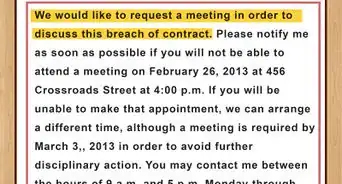This article was co-authored by Scott Levin. Scott Levin is a Divorce Mediator & Family Lawyer, as well as the Founder of San Diego Divorce Mediation. With nearly 20 years of experience, he specializes in peacefully mediating divorces so couples split amicably. He holds a law degree from the University of Chicago School of Law and a Bachelor’s degree in Metropolitan Studies from New York University. Additionally, Scott is a licensed attorney in California, a Certified Divorce Financial Analyst, and a member of The Academy of Professional Family Mediators.
There are 10 references cited in this article, which can be found at the bottom of the page.
This article has been viewed 36,968 times.
When you’re getting married, you can’t believe anything could go wrong. Unfortunately, it often does. A prenuptial agreement can help avoid much of the argument and litigation that often comes with divorce. Even when a marriage lasts until death, a prenuptial agreement can help determine how to distribute assets by determine what is and is not property of the deceased spouse. This article will help you do that.
Steps
Talking With Your Future Spouse
-
1Disclose current assets. Each future spouse should disclose their current income and assets for the following reasons:[1]
- Most states require either reasonable disclosure or full disclosure in order for a prenuptial agreement to be valid.
- A person cannot legally contract away something they have no way of knowing they may be entitled to.
- If your future spouse later learns about assets you have hidden, this will likely create arguments that could lead to divorce.
-
2Develop future financial plans. The contract you are making is for future occurrences. Therefore, you should consider the potential changes in your financial situation. Think about things such as:
- The potential for starting and maintaining a successful business.
- Any plans for obtaining higher education that will likely lead to higher income.
- Realistically anticipated inheritances to either spouse.
- Plans for one spouse to leave the job market at any point, such as with the birth of children.
Advertisement -
3Discuss provisions for extended family. This is especially important if there are children from prior marriages and is a common concern for older couples. If there are specific properties that either party wants to pass on to that other person, these provisions should be included in the prenuptial agreement so that they do not become marital property.[2]
-
4Decide how property and finances will be handled during the marriage. Even in most community property states, property (including money) can be separately owned unless specifically registered as joint property if it is contracted in a valid prenuptial agreement.
- You can specify that only jointly owned bank accounts or other personal property are marital property
- One spouse can waive joint ownership of real property with the other spouse
- Be aware that if this arrangement is grossly unbalanced and one spouse owns everything with the other spouse owning nothing, a court is likely to set aside the prenuptial agreement
-
5Develop a plan for distributing property in case of divorce. Once you have decided what you hope you financial future to be, start considering ways to split it up if something happens between you. This doesn’t even have to be a divorce. There could be reasons you would want to separate properties even during your marriage, such as to protect one party from the debts of the other one. Plan for:[3]
- How real property, including the marital home, will be distributed
- How businesses will be divided
- How any jointly owned liquid property (such as cash and stocks) will be divided
- Whether one person will receive a cash settlement in lieu of property and how that value will be calculated
- Whether alimony or spousal support will be awarded, and what criteria will be used to calculate the amount
-
6Talk about non-financial issues. While you don’t want to include non-financial issues in your prenuptial agreement, you do want to discuss them. Frequently, non-financial issues will impact your financial situation. Most of these things are unenforceable if put in a contract. They include:[4]
- The custody of any children can only be decided based on the best interest of the child at the time the decision is being made. Any attempts to contract about this will be ignored.
- How household duties will be divided. These are unenforceable in a prenuptial agreement, but discussing them will help avoid unrealistic expectations regarding the ability to hold down meaningful employment and also be primarily responsible for the children and household. You can address this somewhat in detailing that if one party does exit the workforce to care for the home, that person will be compensated in a certain way if the marriage fails.
- Behaviors during the marriage can be encouraged, so long as those cannot be interpreted to encourage divorce. You can include such things as bonus payouts to one spouse if the marriage lasts certain durations or penalty payments for infidelity.
Putting the Agreement in Writing
-
1Identify the parties and the document. After titling the document something like “Premarital Agreement”, you want to identify the two parties by full, legal names and state that they are both willingly entering into the agreement.[5]
-
2State the intent of marriage. You need to state that the parties are not currently married, but intend to marry. You can, but do not have to include the date of the intended marriage. You also want to state that the date of marriage is the effective date of the contract unless you want the agreement to be effective on some other date.[6]
-
3Define any special terms used. You can define any terms you use in the document, even if your definition conflicts with the way those terms are defined in some statutes. Some terms you may want to define include:[7]
- Income
- Business
- Infidelity
-
4Describe the current assets. You should describe each party’s current assets and income. This lets a court know what you disclosed when making a determination of fair or complete disclosure. You can do this by making addenda of:[8]
- A list of assets for each party
- A financial statement for each party
- Be certain these addenda are current and dated
-
5Describe how increases or decreases in property or income will be managed during the marriage. When property is bought or sold or income increases or diminishes during the marriage, these things must be considered in the agreement. Commonly:
- Property purchased and maintained with earnings or assets of only one spouse may be considered that spouse’s property.
- Property purchased with funds or assets held jointly will need to be distributed.
- If one party uses funds or assets for the benefit of the other party and at the detriment of him/herself, that person can be compensated for the detriment suffered (such as selling off assets or leaving school to put the other spouse through medical school).
-
6Define any protections for either party during the marriage. Sometimes joining the financial status of the other spouse could be detrimental. In these cases, you may want to include a statement that one spouse is not responsible for certain liabilities of the other spouse. This may include:
- When one spouse has a high amount of debts
- When one spouse is undergoing litigation that may adversely impact their financial status
- When one spouse has responsibilities to other people that the other spouse does not want to accept, such as elderly parents, prior spouses, or children from a prior relationship
-
7Describe how property will be distributed at the end of the relationship. It is easy to determine that separate property will go with its owner, but there will likely be assets held jointly in the marriage. Those assets need to be divided. Here are some common plans, though you should feel free to devise your own.
- The marital home often goes to the spouse who lives with the children the most time
- Where two spouses developed a business together, one will frequently buy the other’s interest in the business, or the business will be dissolved and the value split.
- If an asset is encumbered, such as by a loan, responsibility for the liability often goes to the person who is retaining the asset.
-
8Avoid addressing certain items. A prenuptial agreement is designed to address financial issues only. There are certain things that cannot be addressed in a prenuptial. In most cases, if you address one of these items, a judge will simply ignore that provision. If there are many of them, a judge may set the entire agreement aside. Some things that are prohibited from a prenuptial agreement include:[9]
- Child custody
- Child support, though some states will allow provisions for increased support based on certain events, such as one parent will pay private school tuition if there are children attending private school
- A court cannot enforce any division of household labor
- Some states prohibit the waiver of alimony, but other states allow it so long as the waiving spouse does not qualify for public assistance upon divorce
-
9Be aware of reasons a court may ignore a prenuptial agreement. A court will likely ignore provisions that are unenforceable, such as provisions for child custody, but there are certain things that may prompt a court to set aside the entire agreement. These include:[10]
- A failure of one party to properly disclose assets
- An agreement that is so one-sided as to leave one spouse destitute and the other in good financial status
- A failure to allow one party the opportunity to get legal or other advice and to contemplate signing the agreement
- Including a provision that can be interpreted to encourage a divorce
Complying With the Formalities
-
1Provide the required disclosure. Check the statutes in your state to see the level of disclosure required. You can usually find a link to the statutes on the websites of your legislature, your highest court, or your governor’s office.[11]
- Full disclosure means that you must disclose all assets, liabilities and income to the other party.
- Fair disclosure varies in meaning from state to state, but is typically less than a requirement that everything be disclosed. Consult an attorney or search case law to learn how your state defines fair disclosure.
- Google Scholar now includes a searchable database of case law for all 50 states. Choose your state and search on keywords “fair disclosure” and “premarital agreement”.
-
2Provide adequate time for review. A prenuptial agreement is likely to be set aside if both parties don’t have adequate time to review it. Most states only require a “reasonable” time period that is not clearly defined and will depend on the circumstances. [12]
- One day is generally not enough.
- Seven generally is enough under normal circumstances.
- If the parties are in a position that it would not be feasible to get legal or other advice regarding the agreement (such as being on a cruise or away for an extended business trip), seven days may not be considered “reasonable”.
-
3Encourage the other party to obtain legal advice. Both parties to the agreement should be aware of what they are signing. This means more than just knowing it is a prenuptial agreement. Both parties should have the opportunity to have an independent professional review the document and advise them of the benefits and risks of signing that particular document as it affects that person’s individual circumstances.[13]
Expert Q&A
-
QuestionHow do you respectfully ask for a prenup?
 Scott LevinScott Levin is a Divorce Mediator & Family Lawyer, as well as the Founder of San Diego Divorce Mediation. With nearly 20 years of experience, he specializes in peacefully mediating divorces so couples split amicably. He holds a law degree from the University of Chicago School of Law and a Bachelor’s degree in Metropolitan Studies from New York University. Additionally, Scott is a licensed attorney in California, a Certified Divorce Financial Analyst, and a member of The Academy of Professional Family Mediators.
Scott LevinScott Levin is a Divorce Mediator & Family Lawyer, as well as the Founder of San Diego Divorce Mediation. With nearly 20 years of experience, he specializes in peacefully mediating divorces so couples split amicably. He holds a law degree from the University of Chicago School of Law and a Bachelor’s degree in Metropolitan Studies from New York University. Additionally, Scott is a licensed attorney in California, a Certified Divorce Financial Analyst, and a member of The Academy of Professional Family Mediators.
Divorce Mediator & Family Lawyer Well, you've got to remember that a prenuptial agreement is needed to prepare the terrain to a possible divorce. It sounds weird, given that you're both looking forward to the marriage, but remind your partner that it's better to do this while you're in a better headspace than you would be if you were getting a divorce. Try saying that and involving your partner from the beginning, so they're not caught off guard.
Well, you've got to remember that a prenuptial agreement is needed to prepare the terrain to a possible divorce. It sounds weird, given that you're both looking forward to the marriage, but remind your partner that it's better to do this while you're in a better headspace than you would be if you were getting a divorce. Try saying that and involving your partner from the beginning, so they're not caught off guard.
Expert Interview

Thanks for reading our article! If you'd like to learn more about prenuptial agreements, check out our in-depth interview with Scott Levin.
References
- ↑ http://www.legalmatch.com/law-library/article/failure-to-disclose-assets-and-prenuptial-agreements.html
- ↑ http://www.angelascarlato.com/Articles/Should-you-sign-a-prenuptial-agreement-before-your-New-York-wedding.shtml
- ↑ http://family.findlaw.com/marriage/managing-marital-property-do-s-and-don-ts.html
- ↑ http://family.findlaw.com/marriage/what-can-and-cannot-be-included-in-prenuptial-agreements.html
- ↑ http://family.findlaw.com/marriage/sample-premarital-prenuptial-agreement.html
- ↑ http://family.findlaw.com/marriage/sample-premarital-prenuptial-agreement.html
- ↑ https://www.pandadoc.com/prenuptial-agreement-template
- ↑ http://www.prenuptialagreements.org/prenuptial-agreement-sample/
- ↑ http://family.findlaw.com/marriage/what-can-and-cannot-be-included-in-prenuptial-agreements.html
- ↑ http://www.forbes.com/sites/jefflanders/2013/04/02/five-reasons-your-prenup-might-be-invalid/
- ↑ http://greerlawfirm.net/prenuptial-prerequisites-the-4-essential-elements-of-an-inviolable-agreement.htm
- ↑ http://nationalparalegal.edu/public_documents/courseware_asp_files/domesticRelations/ContractsMarraige/PremaritalAgreements.asp
- ↑ http://greerlawfirm.net/prenuptial-prerequisites-the-4-essential-elements-of-an-inviolable-agreement.htm











































































